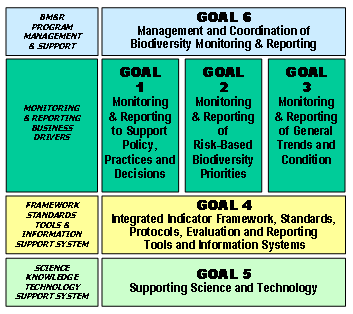Introduction
Implicit within the mandate of the Ministry is a role for monitoring and reporting
on the condition of the province’s air, water, land, fish & wildlife
species, and the effectiveness of regulatory mechanisms to protect
them. Simultaneously, the Ministry is moving toward an environmental
management
model of shared stewardship, based on tracking environmental
standards rather than prescribing rules. The ability to monitor
and report on the environment in a manner that is ecologically
relevant, scientifically credible, and cost-effective has never
been more important.
The Omineca Region Ecosystems Section plays a role in the following
three types of Monitoring:
Compliance Monitoring
Compliance monitoring measures performance against some environmental
standard required by law, and may include audits, assessments,
and reviews. Compliance monitoring entails ensuring operational
alignment with the Ministry’s legislation, regulations,
and policies. Compliance with legal environmental regulations
is central to the Province’s commitment to a clean, healthy
and naturally diverse environment that enriches people’s
lives, now and in the future.
The movement to results-based environmental performance requires
alternative and continuously improving approaches to compliance,
and less dependence on the more traditional enforcement approach
to compliance.
The Omineca Ecosystems Section participates on an inter-divisional
Compliance Committee that facilitates communication, cooperation,
and teamwork among divisions, regions, Victoria, other ministries
and governments, and partners on all compliance-related issues.
In 2000 & 2001, Ecosystems staff assessed approximately
60 culverts throughout the Prince George Timber Supply Area,
checking indicators of fish passage, and compliance with the
stream crossing standards of the day. The specific results of
this assessment project have been shared with the forest licensees
whose culverts were part of the project, and with the Ministry’s
project partners, including Ministry of Forests and Department
of Fisheries and Oceans. Due to the quantity and nature of problems
detected from this initial assessment work, the Ministry will focus
its efforts in the future on the issue of maintaining fish passage
at stream crossings.
The Omineca Ecosystems Section will do
more compliance monitoring. We are specifically asking the question:
“ Have
a sample of individual closed bottom structures installed on
high risk fish bearing streams between 1995 and 2003 been installed
and maintained in a manner that ensures fish passage for all
life stages of fish?” This project pertains to compliance
under the Forest Practices Code, and to Forest and Range Practices
legislation requirements for stream crossing installations completed
and maintained since June 1995.
Study Areas
Study areas for this compliance monitoring project will include
the north portion of the Willow River Watershed, northwest portion
of the Parsnip watershed, the Herrick watershed, the Upper Torpy,
and the Mackenzie Forest District portion of the Nation watershed.
These five study areas have been chosen because they generally:
- Contain high fish values
- Have not been subject to previous fish passage assessments
by the Ministry
- Are logistically achievable
- Will represent a diversity of licensees
Effectiveness Monitoring
Effectiveness monitoring measures environmental condition in
the context of a program, policy, plan, or activity, to gauge
progress toward its desired outcomes or effects.
There is an important distinction between compliance and effectiveness.
Compliance monitoring addresses whether people are complying
with environmental standards (e.g., is a forest licensee retaining
a riparian buffer as required?). Effectiveness monitoring attempts
to uncover whether those standards are having an effect in the
environment (e.g., does the buffer retain the ecological character
of the riparian area?)
Biodiversity Monitoring
Biodiversity is the diversity of plants, animals, and other
living organisms in all their levels of organization, including
the diversity of genes, species, and ecosystems, as well as the
evolutionary and functional processes that link them.
The Omineca region participates in provincial biodiversity
monitoring & reporting working groups, with the vision of
informing and improving policy and practices for ecosystem conservation
and management that affect biodiversity in B.C. This vision will
be achieved through:
- Collecting, analyzing, and interpreting science-based information
over time and across the province at a range of scales.
- Providing resultant information to decision-makers, practitioners,
other stakeholders and the public.
- Partnering with a coordinated network of public and private
stewards.
This figure shows the Biodiversity
Monitoring & Reporting Strategy Framework goals. Goals
1,2, and 3 represent different monitoring and reporting business
needs, while Goals 4,5, and 6 provide important support functions
for those business needs.

A number of projects that fit within the umbrella
of Biodiversity Monitoring & Reporting have been completed
and continue to run within the Omineca region. For details on
specific regional
projects that involve biodiversity monitoring, see the
Fisheries and Wildlife pages.
|